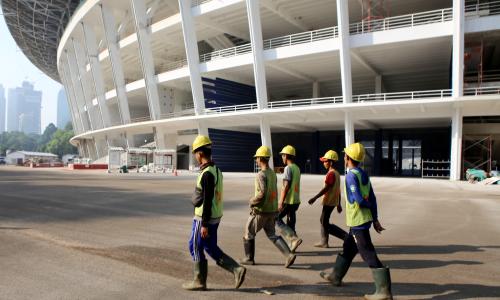
Greening up Asian Games as energy of Asia
This article was originally published in The Jakarta Post on June 28, 2018.
When Indonesia hosted the fourth edition of the Asian Games in 1962, president Sukarno used the opportunity as a coming-of-age moment for the young nation. The famous Gelora Bung Karno Stadium, Hotel Indonesia, Selamat Datang Monument, the Sarinah department store and Semanggi Interchange were built for the Games, and Indonesia was proud to point out that all the mega infrastructure — which is still functional and remains an integral part of the city — was built in only a short period of time.
When they were built, not only did they help transform the image of Jakarta from a big kampung to a cosmopolitan city, they also instilled a sense of pride among Jakartans and Indonesians.
The messages highlighted inwardly and outwardly to the world by Indonesia during the 1962 Games were loud and clear: Indonesia is a developing nation undergoing rapid modernization.
This year, Indonesia was again given the opportunity to host the Asian Games, this time with the slogan “Energy of Asia”. Despite the display of many banners, images and skyscrapers carrying the slogan, we hear no clear narrative about what Energy of Asia means.
The official website briefly mentions that the slogan reflects the nation’s diverse cultures, languages and history which, when fused together, will drive Indonesia to attain a key global power status.
Unfortunately, this has not been emphasized enough. As a multisport event involving over 9,000 athletes from 45 nations in Asia, the Asian Games holds promise to raise awareness and influence public opinion over certain issues.
This is not only because the Games itself is a mega event, but also because sport is universal, gaining participation, attention and passion from almost all members of the public. Asian Games momentum should therefore be used to highlight certain issues important to Indonesia and the world. One of such issues is sustainability.
The government has actually started pushing several green projects in this year’s Asian Games. Gelora Bung Karno Stadium in Jakarta and Gelora Sriwijaya Stadium in Palembang, South Sumatra, for instance, have installed LED lights and solar power infrastructure to save energy and reduce greenhouse gas emissions.
Green public areas have also been built around sporting infrastructure in both host cities. While this is a promising move, the sustainability message should go beyond the arena of sports.
Forests are one of the often overlooked ecosystems that are key to our sustainable growth. Home to rich biodiversity and the world’s third-largest tropical forest area, Indonesia is a strategic partner in mitigating global climate change. Unfortunately, forest cover loss in Indonesia is taking place at an unprecedented rate.
Forest cover loss in Indonesia peaked at 928,000 hectares (2.3 million acres) in 2012 and 735,000 ha in 2015, almost five times the size of London.
The deforestation was also frequently accompanied by fires. The infamous transboundary haze in 2015 that affected Indonesia and its neighboring countries disrupted flights, caused respiratory illness and emitted catastrophic amounts of CO2.
President Joko “Jokowi” Widodo has thus emphasized the need for fire prevention leading up to the Games, given that South Sumatra had among the most fires in 2015, reaching almost 10,000 fire counts according to Global Forest Watch Fires. This year, the Games will take place during the dry season, when the forest fire count tends to surge.
Indeed, forest protection brings benefits to global communities. Just as it is with the definition of energy, forests make things work. Tropical forests provide essential services, including hosting biological diversity, supplying clean water and capturing carbon, making forests an essential element of any strategy to stabilize our climate. Destructing forests hence will result in losses in communities.
For instance, the forested watershed surrounding Jakarta ordinarily stores and slowly releases rainwater, promoting the aquifer recharge process and stabilizing soil and stem erosion.
However, deforestation in the upstream watersheds have left Jakarta in a vulnerable position to meet the surging demand for water as well as protect against flooding, landslides and water stress.
How can Green Energy of Asia be translated and communicated?
Outwardly, the slogan “Energy of Asia” could be translated to highlight Indonesia as a green and environmentally friendly nation, for instance, by emphasizing the country’s commitment to sustainable development, starting from the inclusion of environments’ carrying capacity in development planning and the ambitious greenhouse gas emissions reduction target, to large-scale forest and peatland restoration. Local governments, such as South Sumatra’s, have also promoted green growth to protect forests and peatland while considering alternative livelihoods for communities to prevent burning.
Inwardly, the green message could be used by the government to raise awareness about forest protection and green development and implore its citizens to live a greener, healthier lifestyle. For example, the government could run a campaign to produce less waste, dispose of waste properly and encourage the use of compostable packages, especially during the Games.
Similarly, transportation could be made greener during the Games. While the government has said it would provide nonfossil fuel-based vehicles to transport athletes and spectators within the sports complexes, a campaign that encourages members of the public to walk, cycle and use public transportation, such as the newly established light rapid transit (LRT) system, could also be organized.
There will hopefully be changes in awareness and the behavior of the public that will last beyond the Games.
Now, as our athletes are getting their energy ready for scoring big in the Games, we should also unite to green up the Asian Games as the Energy of Asia.